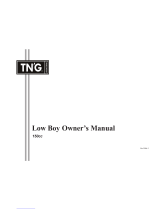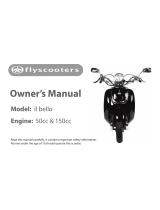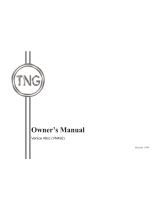Page is loading ...

2
Introduction
This manual is intended as a real world manual for all GY6 scooters.
This is
only a supplement to the manual provided by your dealer or manufacturer.
Most
of the manuals provided with Chinese scooters are very difficult to understand
and most do not have the
information you need to properly care for your scooter.
Within these pages you will find instructions for common maintenance
procedures. You will also find many specifications that you won t find in common
owner s manuals, such as valve gap settings, etc. These values have been
obtained from what are believed to be reliable sources but cannot be guaranteed
to be correct.
A complete shop manual for the 50cc GY6 can be downloaded at
www.ScootDawg.com
The vast
majority of information also applies to the 125cc
and 150cc GY6.
Safety Warning
Please refer to your original manual for recommended safety precautions. It is
up to you to comply with
all federal, state and local
laws and regulations. Do not
operate
or work on your scooter under the influence of mind
-
altering substances.
Always wear proper protective gear when riding or working on your scooter. It is
recommended that you take a motorcycle safety course if you are a new rider.
This is copyrighted
material. Scootdawg will pursue violators!
Table of Contents
Page
3
Pre
-
Delivery Instructions
4
Gauges and Controls
6
Starting/Break
-
in Procedures
7
Changing the Oil
9
Changing Gear Oil
10
Air Filter
11
Spark Plug
12
Idle Adjustment
13
Carburetor Tuning
14
Brakes
16
Caring for and Storing
17
Maintenance Schedule
18
Torque Settings
21
Valve Adjustment
22
Body Panels
23
Reading Spark Plugs
www.ScootDawg.com

3
Pre
-
Delivery Inspection (P.D.I.)
If you purchased y
our scooter from a local dealer, they should have
already performed a P.D.I. If you purchased it on the internet, you must perform
your own. Not doing this can result in malfunction of your scooter and could
re
sult in serious injury or death
. The follow
ing is a typical P.D.I. checklist.
*Check all nuts & bolts for tightness
*
Check fuel lines for kinks and proper
connect
ion
.
*
Fully charge the battery before
installing.
Battery location under the
floor
========================
*
Check spark plug gap. G
ap to
.035
.
*
Check tire pressure
(Improper tire
pressure will greatly reduce
performance and safety).
*
Check
functioning of all switches and
electrical components
*
Check brake fluid level
*
Check oil level
*
Check brake levers for proper free
play
*
Check su
spension for proper functioning
*
Check wheels for alignment, free rotation and proper tightening
*
Check headlight aim
*
Check for fuel and oil leakage
*Although not common, you may want to consider bleeding your disc
brakes. Some owners of less expensive
Chinese scooters have reported
improperly bled brake lines out of the factory. The easiest
and most
effective
way to do this is to
purchase an inexpensive brake
bleeding kit at an auto
parts
store. Follow the instructions
with the kit.
www.ScootDawg.com

4
Gauges and Controls
With so many body styles available, the location of your controls may differ and
you may have
some not
included here
but this will give
a good generic
indication of the
gauges and
cont
rols found
on a scooter.
Your controls
function as
illustrated.
Ignition Switch:
On Position
-
Electrical Circuits are
on, scooter can be started, key
cannot be removed.
Off Position
-
Electrical circuits are
off, engine is off, key can be
removed.
To lock steering, turn the
handlebars to the left, push the key
in and turn it to the lock position.

6
S
tarting your Scooter
T
he
left
brake lever
must be held
in
to start the scooter
.
Some scooters also
come with a safety switch built into the
side kickstand and will not start with the
side stand in the down position. Make
sure the ignition switch is fully on and
that the kill switch is in running position.
Never leave your sc
ooter running on the
side stand.
T
he back wheel could turn
and dump your scooter onto the ground.
Never operate the electric ignition more
than a
few seconds at a time or you will
burn the unit out. If you have made more than five repeated attempts to start
your scooter, stop and let the starter cool down for a couple minutes.
Use the kick starter if the battery is
dead. Make sure to return th
e foot peg
to the original position after using.
To use the kick, the ignition must be on.
Some scooters require that the brake be
held in.
Engine Break
-
In
Most manu
facturers
recommend that you not run your scooter at more than
2/3
throttle before i
t is
broken in (around
6
00
-
1000
miles).
A new school of thought
has emerged that many enthusiast now follow. You can read about the
hard
break
-
in
method
and make your own decision.
http://ww
w.mototuneusa.com/break_in_secrets.htm
The main rule you need to follow is to NOT maintain a constant engine speed for
extended periods of time.
www.ScootDawg.com

7
Changing the Oil
The oil should at a minim
um be changed after the first 300km (180 miles) and
every 1000km (600 miles) after
that.
It doesn t hurt to change it
after the
first 50 miles.
New
engines can produce small
shavings in the first few miles
that can be abrasive to the
internal parts.
It
helps for the engine to be
warmed (not hot) at the time of
change.
Place a
drain pan under the
drain plug. Remove the filler cap, then
remove
the
drain plug
.
When you remove the drain
, these parts will come out
5=screen
filter
, 6=spring,
7=gasket, 8=plug
.
Blow out the screen with compressed air to clean.
Gently depressing the kick starter five or six times
will flush out remaining oil that does not drain freely.
Make sure the ignition switch is in the off position
while doing this
.
After oil is thoroughly drained, replace plug
components
in the configuration shown.

8
Fill oil as shown using a funnel
.
Use high quality 10w40
or 5w30
synthetic oil.
Capacity is approximately
0
.9 liter. Check the level using the dipstick. Do not
screw the dipstick in while check
ing the level. Do not overfill.
Replace filler cap. Check for leaks.
Take a short ride and check the
level and for leaks again.
www.ScootDawg.com

9
How to Chang
e Gear Oil
Tools you will need
1.
10 mm wrench
2.
Pistol grip oil can
3.
75w90 gear oil 110cc (3.7 oz.)
4.
Measuring cup.
Do the following
while the scooter
is warmed (not
hot). Measure
110cc (3.7 oz) of
gear oil into a
measuring cup.
Pour the oil into
the pist
ol grip oil
gun. Spread a
towel under the
drain plug and
place measuring
cup under drain
screw. Remove
the drain screw
and fill screw and
let oil flow out into
the measuring cup. Removing the fill screw at this time helps the oil drain more
freely. Usi
ng the measuring cup lets you know if you ve lost some oil. Once the
oil is fully drained, replace the
drain screw.
Insert the tube of the oil gun
toward the rear of the oil box
and squirt the oil gently into the
box. Don t squirt so fast that the
oil
doesn t have time to flow into
the
box. Once you have
emptied the can, replace the fill
screw. Wipe everything down
and observe for leaks. Take a
short ride and observe for leaks
again.

10
Air Filter
The air filter on the GY6 scooters is usually found
in one of two places. One is
on the side next to the kick start.
Some models have it located
under the seat. Some of the
newer models may have it located
somewhere else but it should be
easy to find.
Cleaning the air filter is important.
A dirty filt
er will cause poor
performance and decreased fuel
economy.
L
ocate the screws to the plastic cover and
remove. The filter is most likely a foam filter
which can be cleaned. Some models, such
as United Motors, are equipped with filters
that need to be r
eplaced.
Clean the filter in a pan of
kerosene or
mineral spirits.
Squeeze
out
excess solvent. Don t twist or tear the filter. Apply oil to the filter
and squeeze out excess oil. The filter
should be damp but not wet.

11
Spark Plug
NGK C7HSA
or NGK CR7HSA
The
CR7HSA has a resistor to
keep radios from buzzing
due to the magneto/coil's electrical
interference.
The spark plug can be found
behind this hatch.
The spark plug should be cleaned every time it is
inspected with a sma
ll wire brush. The gap should
also be checked. Always gap a new spark plug.
Most manuals
recommend a plug gap of .7 to .8mm
(.028 to .032 ). Many report better performance at .035 .
A chart on how to read
your plug is included at
the end of th
is manual.

12
Idle Speed Adjustment
150cc=1400rpm +/
-
50cc=1
9
00rpm +/
-
Engine idle speed should be adjusted to 1
400 rpm for the 150cc and 1900 rpm
for the 50cc
. However, when the scooter is new, it may need to be adjusted a
little higher until t
he engine breaks in to prevent dying at stop lights, etc. If you
don t have a tachometer you can adjust by ear. T
he idle should
be adjusted just
high enough so that
when set on the center stand with rear wheel elevated, the
wheel turns very slowly
. Adju
sting the idle is a very simple procedure.
The easiest way to get to the
idle screw is to remove the well under
your seat. Locate the screws and/or
nuts securing the well and remove
them. On most models, the gas cap
must also be removed.
Turn
the screw clockwise to
increase the idle, counterclockwise to
decrease the idle.

13
CARBURETOR TUNING
It is rare
that this procedure is needed, u
sually after major modifications to the
engine or if you live in a very high altitude location
.
This procedure should be performed with the engine warmed.
1.
Adjust idle to 1400 rpm for 150cc or 1800 rpm for the 50cc with idle screw.
2.
Turn air/fuel mix (fuel volume
regulation) screw all the way in gently.
The engine should stop.
3.
Turn the air/fu
el mix screw out ¾ turn
on 150cc, 1 ½ turns on the 50cc.
4.
Start engine and increase idle (with idle screw) to a fast idle.
5.
Slowly turn the air/fuel mix screw out until maximum idle speed is
achieved.
6.
Readjust idle screw to proper idle speed.
7.
Check for sta
bility by accelerating a few times. If engine doesn t
a
ccelerate smoothly, readjust.

14
Brake
s
Rear
Drum
Brakes
If you have more than
¾ free play or feel the
handle bottom out ,
you need to adjust
your brake.
Turn the adjusting nut clockwise f
or a tighter adjustment. Make sure that the
concave side of the adjusting nut is seated securely on the pin. Adjust inward
until free play is 3/8
to ½ . After adjusting, spin the wheel to make sure it spins
freely. Test ride and adjust again if neces
sary.

15
Front (and Rear) Disc Brakes
Locate the window to observe brake fluid level. Make sure master cylinder is
level by placing the scooter on the center stand
and
center
ing
the handlebars.
If the fluid level is low, inspect the
brake pads f
or excessive wear. If
the pads are ok, you are probably
leaking fluid. Replenish fluid with
DOT 3 to proper level.
Brake fluid
WILL damage the finish on your
scooter if you spill it.
Unless you have the necessary
mechanical skills,
leave
more
complicat
ed
brake
work to a
professional.

16
Caring for and Storing Your Scooter
If you are going to store your scooter for extended periods, such as over winter
months, it is important that you do a little preparation. Add a fuel stabil
izer to
your fuel such as Stabil . This will prevent your fuel from becoming unstable
and causing damage to the internal parts of your fuel system. Old fuel can gum
up your carburetor and clog your jets. When you add the stabilizer, it is important
to r
un the engine enough to get the stabilizer worked into the entire system.
The use of a float charger will keep your battery in top condition. Many scooterist
and motorcycle riders keep a float
charger attached whenever the bike
is not in use. This will
extend the life
of your battery and you won t be
surprised with a dead battery at an
inconvenient time. A float charger
will not overcharge and destroy your
battery and can be left on for
indefinite periods of time.
Any other
type of charger left attach
ed to the
battery too long will damage or
destroy it. An Inexpensive float
charger like the one pictured to the
right can be purchased for under $15 at places like Harbor Freight . Some opt
for more expensive ones like Battery Tender that have options f
or installing a
simple plug in.
It is best to store a scooter in
a
garage or shed to protect it from
the elements. If this isn t
possible, use a good quality
scooter cover. It is important
that a cover allows air circulation
so that moisture doesn t
condense on the on the scooter
and cause premature rusting
and possible damage to the
electrical system.
Wrong way to store scooter!
/













